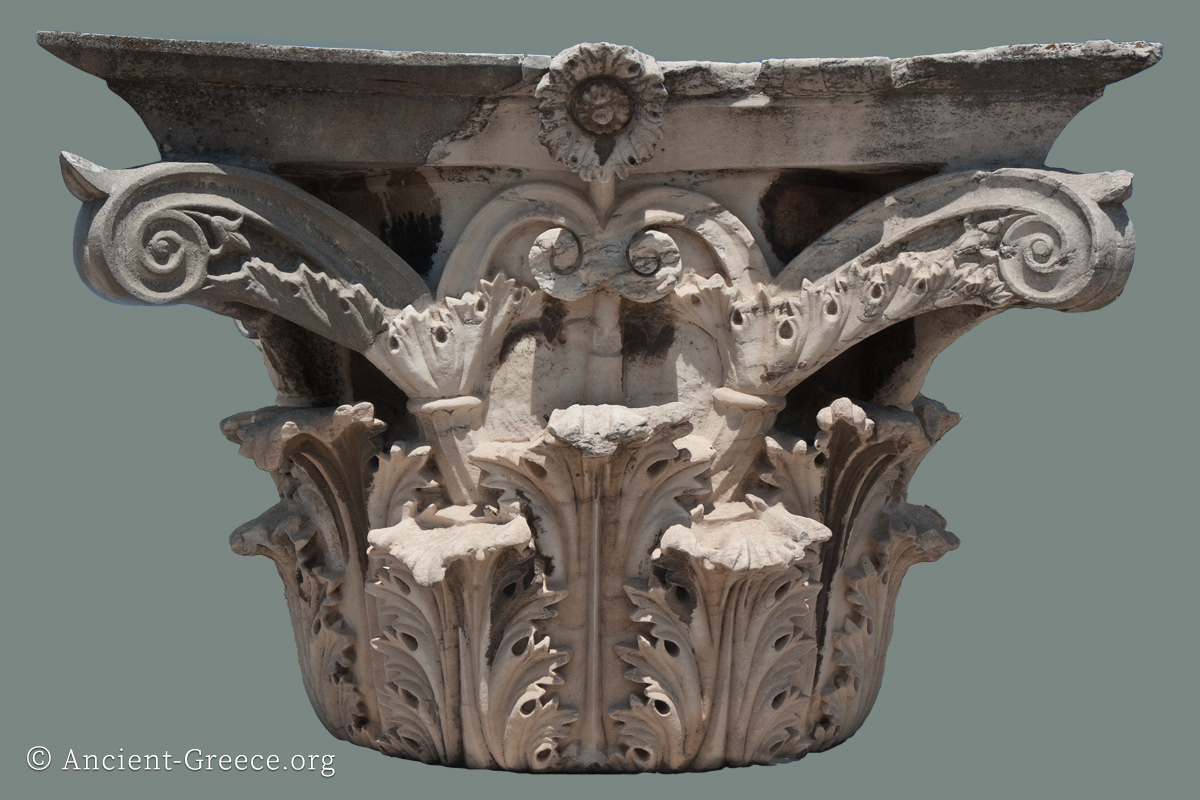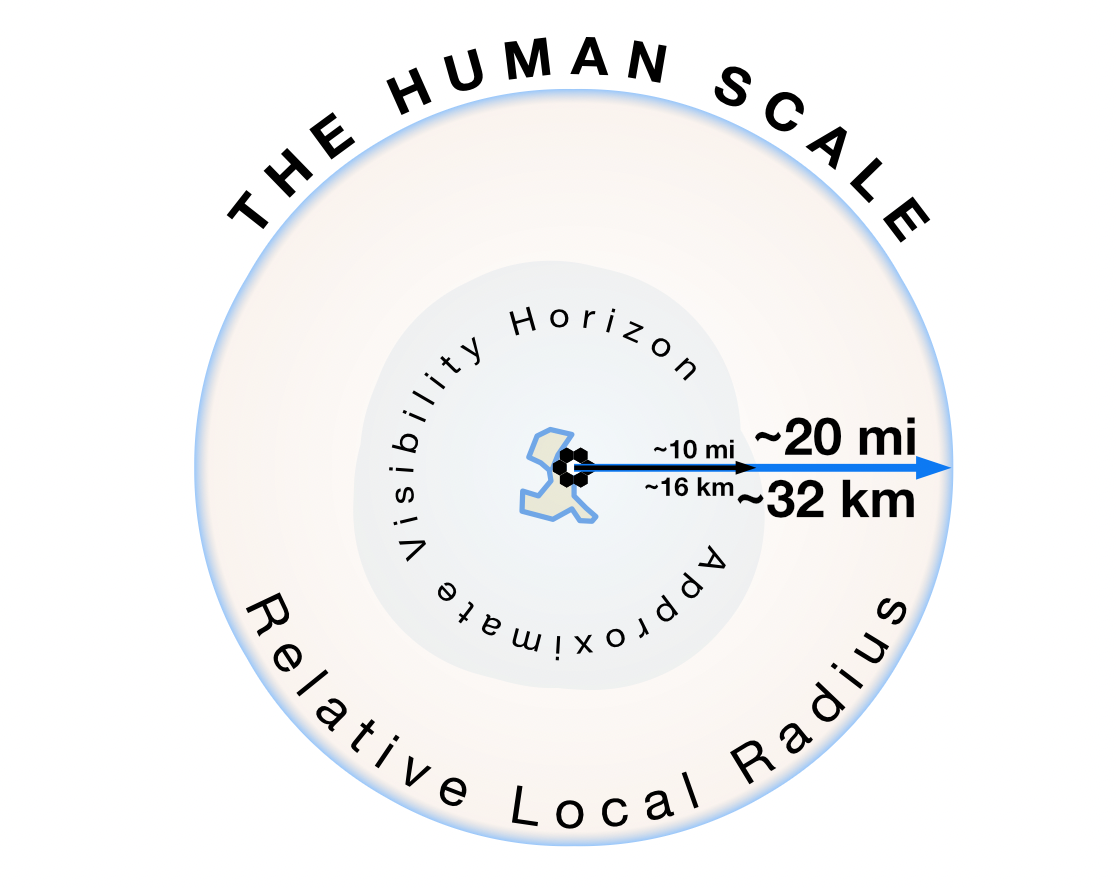
On this page:
Index and Sources
The complete Ancient Greece map contains over 1700 places, each hand-crafted and cross-checked.
A general list of sources can be found in the bibliography, while the map index (περιεχόμενα) contains place-specific sources. In general, trusted sources include a list of their primary sources.
Legend & Design Notes
Base Map
1:10,000,000 (1:10m)
1″ = 158 miles
1 cm = 100 km
The base map was made with Natural Earth
https://www.naturalearthdata.com (NE2_LR_LC_SR_W_DR version 2.0.0, 1/30/2025)
Placemarks & Timemarks
The map attempts to visualize at a glance the story of ancient Greek settlements through time.

Bottom Left: Stone Age (>3000 – 1100 BCE)
Left: Bronze Age (3000- 1100 BCE)
Top Left: Dark Age & Archaic Era 1100 – 480 BCE)
Top Right: Classical Era (480 – 323 BCE)
Right: Hellenistic Era (323 – 30 BCE)
Bottom Right: Roman Era (30 BCE ~ 200 CE)
Black: Major influence for that era
Gray: Lesser influence in that era
Empty: Unoccupied, or unverified occupation in the era
The “placemark/timemark” shows with a quick glance, during which periods a place was relevant (inhabited, administered, etc.) for Hellenic civilization, and what its influence was. In a cluster of cities, the more ancient ones will have hexagons active on the left, while in the later settlements, the right hexagons will be tinted.
The central hexagon indicates the location, which is marked either “certain” (white) when supported by archaeological and authoritative sources, or “approximate” (gray) when relying on other sources, or when the trusted sources are uncertain of the location.
All placemarks are the same size. Relative importance in each era is indicated by the corresponding timemark fill, and the overall influence is indicated by the text size and weight (bold text).
The ring of hexagons surrounding the central place mark indicates influence in each ancient era. They are marked as “major” (black), “minor” (gray), or “not-Greek/unverified/uninhabited” (no fill).
Starting with the bottom left (Stone Age) hexagon and moving clockwise, each hexagon represents a Hellenic civilization’s period of time.
Timemarks are relatively subjective. They indicate the general level of importance of the site, for each era, as construed from the various sources. The sources which are included in the index for each place provide the main guidance in determining each era’s importance.
Some timemarks are tricky to implement, with no universal solutions identified to date. For example, Thessaloniki was founded in 315 BCE by Cassander. So the timemarks for Hellenistic and Roman eras may be filled with black to indicate the city’s importance in these eras. But the city was created by uniting over 26 villages that pre-existed on the site. Given the impossibility of adding them all in such tight space without extra map inserts, the question arises: should the timemark account for their existence in the preceding Classical and Archaic eras when they were not merged to become Thessaloniki? Alexandria in Egypt, along the other cities founded by Alexander the Great were technically in existence for a few years in the Classical Era. Do these few years warrant showing them as active in the Classical Era? Similar problems arise for places that were inhabited but not “Hellenic” during part of their existence. The hope is that the accompanying index of places with the list of sources are useful tools in helping viewers learn more.
Place Names
Ancient Greece spans three thousand years and, naturally, many settlements changed their name over time. Often, the ancients in their own time referred to places by different names or derivatives. To make things more confusing, in subsequent studies over the centuries, transliteration from Greeek to Latin characters never followed consistent rules. As a result, many settlements are known by several name variants.
To fit as many places as possible, only one of the known names for each place is given on the map where space is tight. In that case an asterisk indicates that alternative names for each place can be found in the map index, in their English and Ancient Greek versions.
The following naming conventions are used on the maps to reflect a places’ name variations over the centuries:
Name*: Additional name variations in the index
Name (Name): Other spellings or derivatives
Name, Name: Different names in same era
Name / Name: Name different through eras
Typography
Type size and weight denote the relative importance of each place, but in areas of tight space, a smaller font has been used.
Fonts: Helvetica Neue and Baskerville.
The following typography guidelines give a good approximation of a place’s importance:
12 pt. Name: Place of Renown
10 pt. Name: Place of Influence
8 pt. Name: Place of Importance
7, 6, 5 pt. Name: Place of importance, or influence in tight space
8 pt. Name: Place of note
7, 6, 5, 4.5 pt. Name: Place of note, in tight space
In general, when space is tight, fonts get a click smaller; when space is ample, the largest possible fonts for each significance is used.
Τα Ονόματα στα Ελληνικά είναι γραμμένα με κλίση για να διαφοροποιούνται από τα Αγγλικά όταν παρουσιάζονται μαζί στον χάρτη (names in Greek are italicized).
Colors
The map’s color palette induces the following colors:
FFFFFF
808080
BED7E8
70A7E8
0D79F2
6F898B
1A4548
CF9970
B0558F
F20D0D
Visualizations
Routes
Routes on sea and land are approximate. They indicate a general idea of the direction and reach of travel .
Scale Bar

The scale is very approximate and not to be trusted with precise measurements.
Stadia calculated by measuring the reported ancient distance from Athens to Dekeleia of 120 stadia (Thucidydes).
Human Scale
Several map features have “human scale” indicators to help visualizing distances between places, including a “local city radius”, and a “visibility horizon”.
Human Scale: Local Radius
This feature is not yet published

In an effort to introduce the human scale on the map, a “circle of influence” surrounds each placemark. It represents a reasonable minimum radius of a settlement’s local interactions and influence.
It is a very general mark to enhance the visibility of the area, and to highlight settlement clusters and trends, especially when zoomed-out.
The radius represents approximate walking distance in a day (accepted here as 32 kilometers, or 20 miles, which can be traversed in about 6-8 hours at walking pace), assessed to be the maximum distance where locals would interact with the land, each other, and their neighbors within overlapping areas during a day. Most activity around a city would probably be taking place around a radius of 6-8 miles, which is a distance a person could cover in a couple of hours on foot. A horse/mule or a cart, and other conditions would affect distance and time, but this map does not account for that.
In ancient Greece, a city’s center itself, as well as the surrounding countryside, farms, and villages that provided resources and supported the city’s population, or its polis, extended to a radius of approximately 15-20 kilometers (9-12 miles). The specific radius would vary depending on factors like terrain, population density, and the presence of other nearby settlements. An average person can walk about 25 miles in a day.
The radius does not factor a settlement’s renown or environs, so all radii are equal.

Design Notes: Affinity Designer Multiply Fx on placemark layer gives a nice effect with D3D7CE color on “outline” (and Style” Outline), and 0D79F2 radius outline. A modified gradient fill softens the interior and provides the sharp outline.
Approximate px measurements for city radius (change in “outline” Fx): 41px = 20 mi, 42 km chosen as most appropriate for overall average distance based on approximate maximum walking distance in half a day.
Human Scale: Visibility Horizon
This feature is not yet published

A “shaded” blue area extending out from each island and shoreline indicates an approximate distance of how far a human can see.
Approximate visibility distance on the map is set at 16 km, or 10 mi. This distance would change with the observer’s elevation and atmospheric conditions, so it is a generalization to provide a sense of human proportion to the map. Hopefully it is useful to gauge distances, especially between the islands.
Design Notes: Affinity Designer Fx: Outline (20px = 10 miles)
Era Color Key (this feature is not published yet)
Stone & Bronze
Ages
E0871B
Dark & Archaic
Ages
80B7D9
Classical
Era
D85F5F
Hellenistic
Era
FFEE69
Map Prints
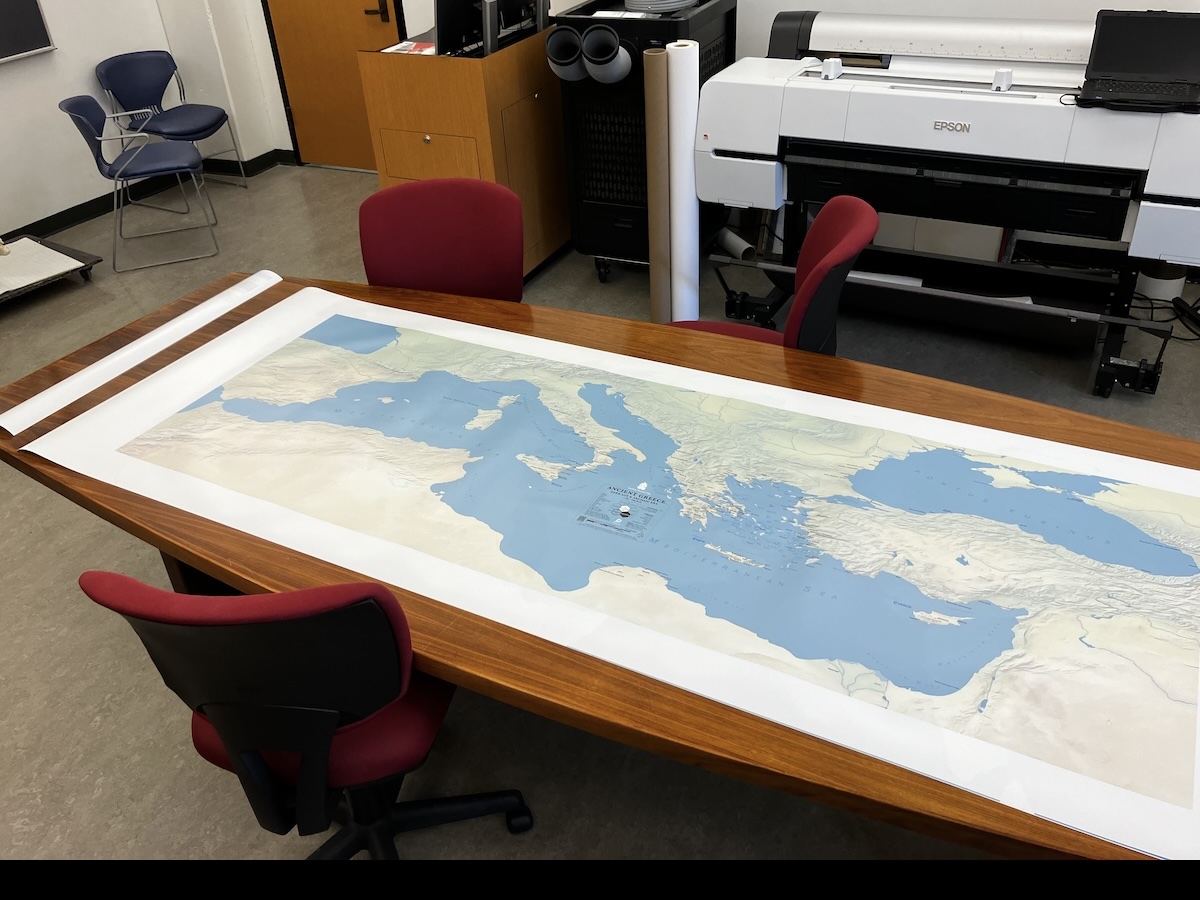
The maps are designed for digital viewing, but they do print very well in sizes appropriate for wall-hanging.
Ancient-Greece.org provides the digital map only and does not sell/provide physical maps. Use your own, or a commercial printer to print the maps in the size you need.
Usage policy: These exclusive maps are free for personal use and research purposes, but reproduction, remixing, embedding, or publication in any form or media, sale, or relicensing is not allowed.
All rights reserved.
Appropriate use of map prints is restricted to research and personal use, or to hang in a private room, or in a physical classroom only. In such case, the map’s legend, copyright notices, and hyperlinks, must remain unaltered, clearly visible, and legible.
Κατάλληλη χρήση εκτύπωσης των χαρτών μας είναι μόνο για έρευνα και προσωπική χρήση, ή για αίθουσα φυσικού σχολείου, ή ιδιωτικού δωματίου. Σε κάθε περίπτωση, το υπόμνημα, οι διαδυκτιακοί σύνδεσμοι, και οι αναγγελίες της πνευματικής ιδιοκτησίας πρέπει να παραμένουν αναλλοίωτα και ευανάγνωστα.
Για εκτύπωση χρησιμοποιήστε τα εργαλεία του προγράμματος περιήγησής σας. Τα PDF μπορούν να εκτυπωθούν σε υψηλή ποιότητα και μεγέθος αφίσας.
Ancient-Greece.org διαθέτει μόνο το ψηφιακό αρχείο. Χρησιμοποιήστε τον δικό σας, ή εναν επαγγελματικό εκτυπωτή.
Design tools used to make these maps

![]()
![]()
![]()
Natural Earth, QGIS, Affinity Designer, PDF. The PDF format was chosen as final output for its simplicity, usability, versatility, and printability.
Satellite Map
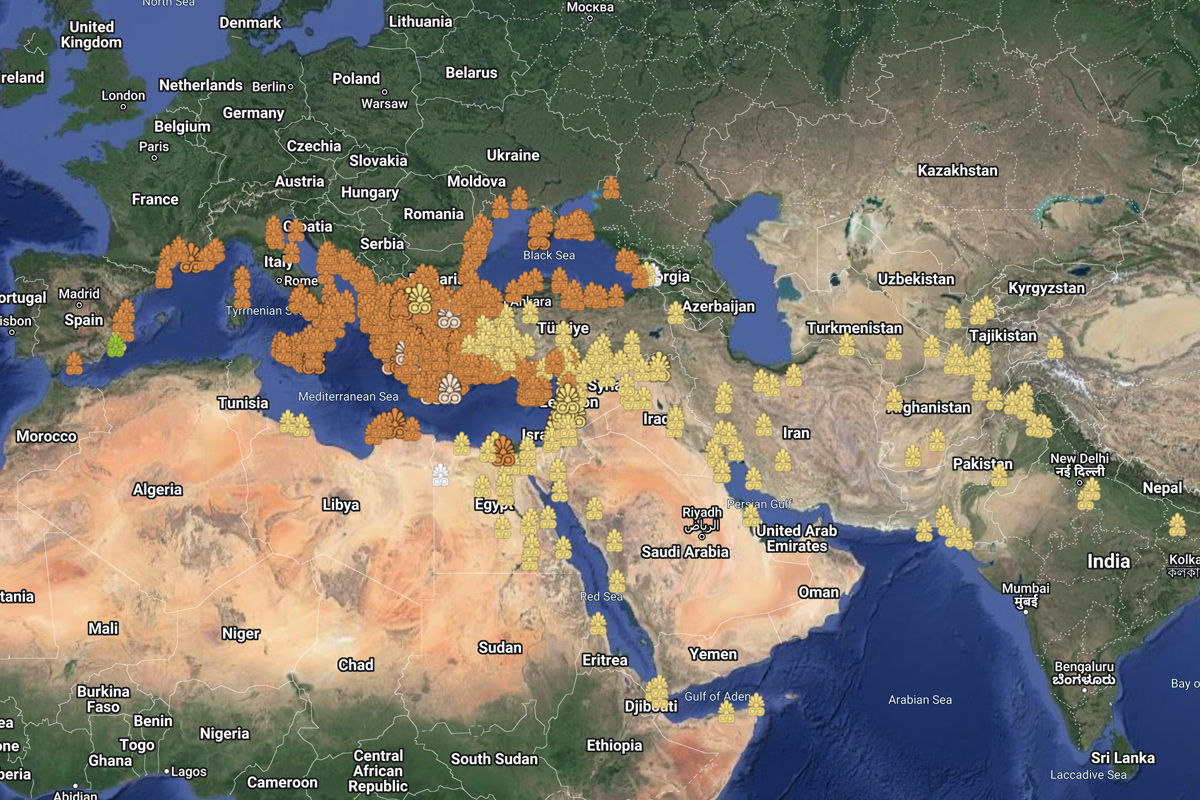
Ancient Greece on Google Maps
Ancient Greece on Google Earth
Placemarks provide general chronological information on Google Maps and Google Earth:
| Multiple eras | Stone Age | Bronze Age | Dark/Archaic Age | Classical Age | Hellenistic Age | Late Hellenistic / Roman |
 |  |  |  |  |  |  |
| 8000 – 3000 BCE | 3000 – 1000 BCE | 1000 – 480 BCE | 480 – 323 BCE | 323 – 146 BCE | 146BCE+ |
Satellite Images and Accuracy of Placemarks
In the Google Maps and Earth versions, the major and minor cities are classified based on the certainty of location. You will find these designations in the pop-up window after clicking on each map place.
Archaeological site: zooming in will show an aerial view of the ancient remains. These are considered “accurate” marks, but the excavated ruins could be a small part of the actual ancient location, which might have relocated several times in the area during over the centuries.
Approximate, or General: The placemark is on the most commonly accepted location based on at least three verified sources, but no ruins or other visual evidence can be seen on the map. They should be considered accurate within the vicinity of the pin on the map.
Probable Location: The exact location of a known place could not be accurately pinpointed on the map. The placemark is placed on the most likely location based on limited information.
The ancient coastline was different in significant places. Today’s satellite imagery offers extraordinary accuracy of the contemporary topography. However, the ancient landscape, and especially the coastline might have been considerably different than today.
Good examples of this are the locations of Troy, Miletos, and Thermopylae. The ancient places existed next to the coast or a large harbor while today, and all satellite images they appear landlocked. In several such cases, I have drawn the ancient coastline based on models from trusted sources.
Back to: Historical maps of Ancient Greece
-
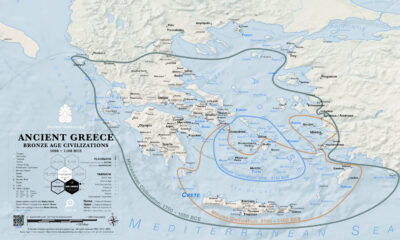
Ancient Greece Maps
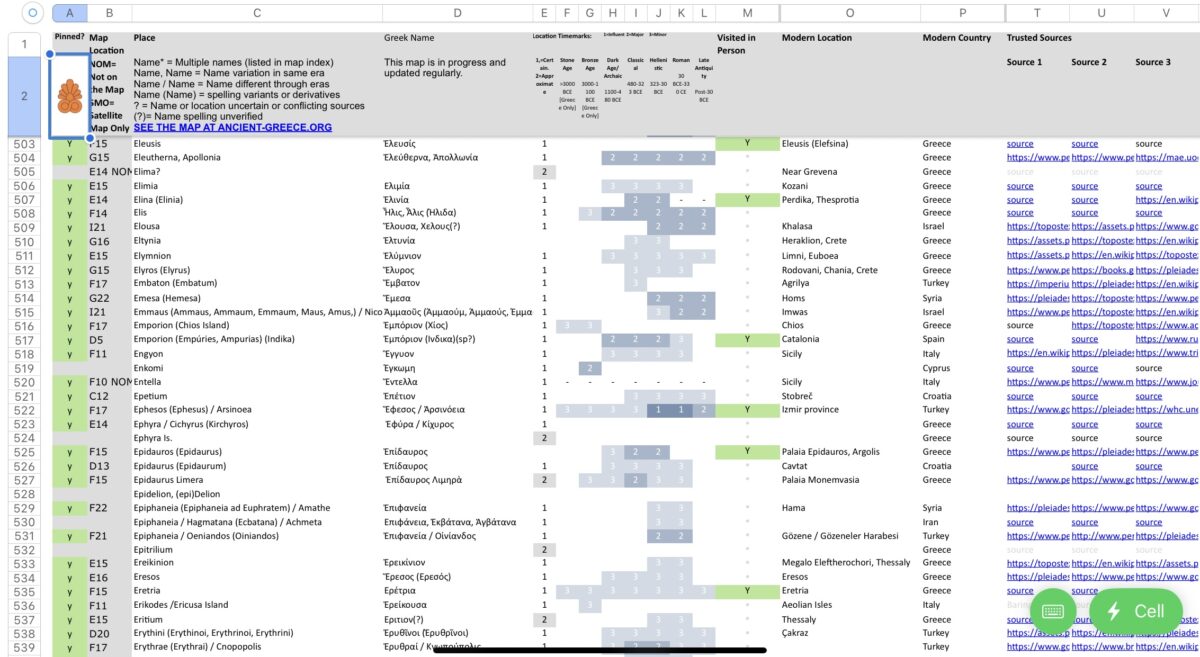
Ancient Greece Map index of places
Current Version and Progress
Version 408 is the latest stable map version. It includes all the major and minor settlements from Iberia, to Euxinus Pontus, to Egypt, to India.
Settlements: ~99% completed
Mountains: in progress
Rivers: in progress
Mines/Quarries: in progress
Land Routes: researching
Sea routes: in progress
Civilizations: in progress
Battles: in progress
Sanctuaries: done
Theaters: done
About these maps
The map aspires to be a trusted research companion for studies in Ancient Greece.
It includes places which were predominantly settled, or administered by Greeks, or Hellenized in ancient times (from the Stone Age to Roman Era: pre-3000 to about 200 CE). It includes settlements and features in the Mediterranean, the Black Sea, the Levant, Egypt, Mesopotamia, Parthia, Bactria, and India. Pre-Bronze Age places, are included for continuity context.
Cropped areas of the map are spawned and published individually to illuminate different aspects of antiquity, areas, and eras.
Development began in 2002, and the map reached its maturity in 2025, with 99% of settlements verified and pinned in version 400. Work continues with corrections, refinements and newly-researched additions.
These maps are part of the author’s research, and are crafted the old-fashioned way: first by designing the base map, then by moving around the ancient landscape, discovering facts, and hand-pinning one dot at a time.
